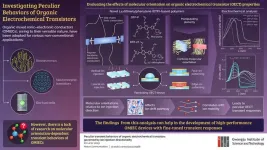(Press-News.org) SAN ANTONIO, Jan. 22, 2024 — A ribbon of brain tissue called cortical gray matter grows thinner in people who go on to develop dementia, and this appears to be an accurate biomarker of the disease five to 10 years before symptoms appear, researchers from The University of Texas Health Science Center at San Antonio (also called UT Health San Antonio) reported.
The researchers, working with colleagues from The University of California, Davis, and Boston University, conducted an MRI brain imaging study published in Alzheimer’s & Dementia: The Journal of the Alzheimer’s Association. They studied 1,000 Massachusetts participants in the Framingham Heart Study and 500 people from a California cohort. The California volunteers included 44% representation of Black and Hispanic participants, whereas the Massachusetts cohort was predominantly non-Hispanic white. Both cohorts were 70 to 74 years of age on average at the time of MRI studies.
“The big interest in this paper is that, if we can replicate it in additional samples, cortical gray matter thickness will be a marker we can use to identify people at high risk of dementia,” said study lead author Claudia Satizabal, PhD, of UT Health San Antonio’s Glenn Biggs Institute for Alzheimer’s and Neurodegenerative Diseases. “By detecting the disease early, we are in a better time window for therapeutic interventions and lifestyle modifications, and to do better tracking of brain health to decrease individuals’ progression to dementia.”
Repeating the Framingham findings in the more-diverse California cohort “gives us confidence that our results are robust,” Satizabal said.
Sifting MRIs for a pattern
While dementias can affect different brain regions, Alzheimer’s disease and frontotemporal dementia impact the cortex, and Alzheimer’s is the most common type of dementia.
The study compared participants with and without dementia at the time of MRI. “We went back and examined the brain MRIs done 10 years earlier, and then we mixed them up to see if we could discern a pattern that reliably distinguished those who later developed dementia from those who did not,” said co-author Sudha Seshadri, MD, director of the Glenn Biggs Institute at UT Health San Antonio and senior investigator with the Framingham Heart Study.
“This kind of study is only possible when you have longitudinal follow-up over many years as we did at Framingham and as we are building in San Antonio,” Seshadri said. “The people who had the research MRI scans while they were well and kept coming back to be studied are the selfless heroes who make such valuable discoveries, such prediction tools possible.”
The results were consistent across populations. Thicker ribbons correlated with better outcomes and thinner ribbons with worse, in general. “Although more studies are needed to validate this biomarker, we’re off to a good start,” Satizabal said. “The relationship between thinning and dementia risk behaved the same way in different races and ethnic groups.”
Applications
Clinical trial researchers could use the thinning biomarker to minimize cost by selecting participants who haven’t yet developed any disease but are on track for it, Seshadri said. They would be at greatest need to try investigational medications, she said.
The biomarker would also be useful to develop and evaluate therapeutics, Seshadri noted.
Future directions
Satizabal said the team plans to explore risk factors that may be related to the thinning. These include cardiovascular risk factors, diet, genetics and exposure to environmental pollutants, she said.
“We looked at APOE4, which is a main genetic factor related to dementia, and it was not related to gray matter thickness at all,” Satizabal said. “We think this is good, because if thickness is not genetically determined, then there are modifiable factors such as diet and exercise that can influence it.”
Derived in clinical MRIs
Could the MRI gray matter biomarker be used widely someday?
“A high proportion of people going to the neurologist get their MRI done, so this thickness value might be something that a neuroradiologist derives,” Seshadri said. “A person’s gray matter thickness might be analyzed as a percentile of the thickness of healthy people for that age.”
Acknowledgments
National Institutes of Health/National Institute on Aging funding for Alzheimer’s Disease Research Centers (ADRCs) at The University of Texas Health Science Center at San Antonio; The University of California, Davis; and Boston University School of Medicine supported this study.
A novel neuroimaging signature for ADRD risk stratification in the community
Claudia L. Satizabal, Alexa S. Beiser, Evan Fletcher, Sudha Seshadri, Charles DeCarli
First published: Dec. 26, 2023, Alzheimer’s & Dementia: The Journal of the Alzheimer's Association
https://alz-journals.onlinelibrary.wiley.com/doi/10.1002/alz.13600
The University of Texas Health Science Center at San Antonio (UT Health San Antonio), a primary driver for San Antonio’s $44.1 billion health care and biosciences sector, is the largest academic research institution in South Texas with an annual research portfolio of more than $400 million. Driving substantial economic impact with its six professional schools, a diverse workforce of more than 7,900, an annual expense budget of $1.46 billion and clinical practices that provide 2.6 million patient visits each year, UT Health San Antonio plans to add more than 1,500 higher-wage jobs over the next five years to serve San Antonio, Bexar County and South Texas. To learn about the many ways “We make lives better®,” visit UTHealthSA.org.
The Glenn Biggs Institute for Alzheimer’s and Neurodegenerative Diseases provides comprehensive dementia care while advancing treatment through clinical trials and research. In addition to patient care and research, the Biggs Institute partners with the School of Nursing at UT Health San Antonio to offer the Caring for the Caregiver program.
Stay current with the latest research from the UT Health Science Center San Antonio on our online Newsroom. Learn about brain research specifically at AdvancingBrainHealth.org.
Stay connected with The University of Texas Health Science Center at San Antonio on Facebook, X, LinkedIn, Instagram and YouTube.
END
Thinning of brain region may signal dementia risk 5-10 years before symptoms
Researchers hope to bring MRI biomarker to dementia risk stratification in patient care, clinical trials
2024-01-22
ELSE PRESS RELEASES FROM THIS DATE:
Zeng researching techniques for achieving supply chain security for the Internet of Things
2024-01-22
Qiang Zeng, Associate Professor, Computer Science, received funding for the project: "Towards Lifetime Supply Chain Security for Internet of Things: Testing an Update Before Trusting It."
The global Internet of Things (IoT) market size is expected to rise substantially by 2029. IoT devices are manufactured by various companies around the world, and thus, should not be trusted by default. Zeng aims to ensure lifetime supply chain security of IoT devices. To attain this objective, he is proposing to test an IoT device and every firmware update through ...
Arafin conducting research aimed at securing chiplet-based semiconductor manufacturing from untrusted supply chains
2024-01-22
Md Tanvir Arafin, Assistant Professor, Cybersecurity Engineering, received funding for the project: "Securing Chiplet-based Semiconductor Manufacturing from Untrusted Supply Chains."
Monolithic integrated circuit (IC) design is reaching the physical limit to accommodate the ever-increasing demand of cramming more transistors in a chip. To address this, novel design primitives that move from monolithic design practices to heterogeneous integration of IC primitives in a 2.5 or 3D structure have emerged. ...
Good and bad news for people with low back pain
2024-01-22
Low back pain is a major cause of disability around the globe, with more than 570 million people affected. In the United States alone, health care spending on low back pain was $134.5 billion between 1996 and 2016, and costs are increasing.
"The good news is that most episodes of back pain recover, and this is the case even if you have already had back pain for a couple of months," University of South Australia Professor Lorimer Moseley says.
"The bad news is that once you have had back pain for more than a few months, the chance ...
GIST researchers investigate strange transient responses of organic electrochemical transistors
2024-01-22
Organic mixed ionic–electronic conductors (OMIECs) are a highly sought-after class of materials for non-conventional applications, such as bioelectronics, neuromorphic computing, and bio-fuel cells, owing to their two-in-one electronic and ionic conduction properties. To ensure a much wider acceptance of these fascinating materials, there is a need to diversify their properties and develop techniques that allow application-specific tailoring of the features of OMIEC-based devices. A crucial aspect of this process is to develop strategies for evaluating the various properties of these ...
Protein discovery could help solve prostate cancer drug resistance
2024-01-22
SPOKANE, Wash. – Researchers have identified a receptor protein known as CHRM1 as a key player in prostate cancer cells’ resistance to docetaxel, a commonly used chemotherapy drug to treat advanced cancer that has spread beyond the prostate. The discovery opens the door to new treatment strategies that could overcome this resistance. This could ultimately help extend the lives of those with prostate cancer, one of the leading causes of cancer deaths among men.
Led by a team of scientists at Washington State University, ...
Improvement of social isolation and loneliness and excess mortality risk in people with obesity
2024-01-22
About The Study: The findings of this study of 398,000 UK Biobank participants support the improvement of social isolation and loneliness in people with obesity to decrease obesity-related excess risk of mortality.
Authors: Lu Qi, M.D., Ph.D., of the Tulane University School of Public Health and Tropical Medicine in New Orleans, is the corresponding author.
To access the embargoed study: Visit our For The Media website at this link https://media.jamanetwork.com/
(doi:10.1001/jamanetworkopen.2023.52824)
Editor’s Note: Please see the article for additional information, including other authors, author contributions and affiliations, ...
In utero exposure to maternal COVID-19 vaccination and offspring neurodevelopment at 12 and 18 months
2024-01-22
About The Study: The results of this study including 2,261 and 1,940 infants ages 12 and 18 months, respectively, suggest that COVID-19 vaccination was safe during pregnancy from the perspective of infant neurodevelopment to 18 months of age. Additional longer-term research should be conducted to corroborate these findings and buttress clinical guidance with a strong evidence base.
Authors: Eleni G. Jaswa, M.D., M.Sc., of the University of California, San Francisco, is the corresponding author.
To access the embargoed study: Visit our For The Media website at this link https://media.jamanetwork.com/
(doi:10.1001/jamapediatrics.2023.5743)
Editor’s ...
Scientists advance affordable, sustainable solution for flat-panel displays and wearable tech
2024-01-22
Key takeaways:
A new 3D-printable material called “supramolecular ink” replaces costly scarce metals with inexpensive, Earth-abundant materials.
The organic material requires far less energy to manufacture than conventional methods.
It could also enhance the sustainability of 3D-printable wearable devices, lighting technologies, and luminescent art and sculpture.
A research team led by Lawrence Berkeley National Laboratory (Berkeley Lab) has developed “supramolecular ink,” a new technology for use in OLED (organic light-emitting ...
Innovate UK, the Urban Future Lab, and Greentown Labs announce the Year 4 cohort for their Global Incubator Programme
2024-01-22
Commencing in January, the Urban Future Lab (UFL) at the NYU Tandon School of Engineering, in collaboration with Greentown Labs, will serve as the supportive entry point in the U.S. for the fourth cohort of Innovate UK’s Global Incubator Programme: Clean Growth edition. This initiative is specifically designed to foster and assist the establishment of innovative climate technology companies demonstrating significant potential for international scalability into new markets.
The annual program extends the opportunity to eight U.K.-based businesses, enabling them to explore the U.S. market and gain access to esteemed mentors over a six-month period.
"We’re ...
KIER Accelerates Carbon-Neutral Technological Innovation through International Collaboration with Horizon Europe
2024-01-22
The Korea Institute of Energy Research (KIER) promotes active collaborations with prominent European institutions, including leading 'Research & Technology Organisations (RTO), prestigious universities, and small & medium-sized enterprises (SME). KIER has consistently stressed the importance of international collaborations in developing evolving and advanced green technologies. As a consequence, the consortium entitled "Scalable High-power Output and Low-Cost MAde-to-measure Tandem Solar Modules Enabling Specialized PV Applications (SOLMATES)", in which KIER participated and worked as a partner with 13 other ...
LAST 30 PRESS RELEASES:
Autistic and non-autistic faces may “speak a different language” when expressing emotion
No clear evidence that cannabis-based medicines relieve chronic nerve pain
Pioneering second-order nonlinear vibrational nanoscopy for interfacial molecular systems beyond the diffraction limit
Bottleneck in hydrogen distribution jeopardises billions in clean energy
Lung cancer death rates among women in Europe are finally levelling off
Scientists trace microplastics in fertilizer from fields to the beach
The Lancet Obstetrics, Gynecology, & Women’s Health: Taking paracetamol during pregnancy does not increase risk of autism, ADHD or intellectual disabilities, confirms new gold-standard evidence review
Taking paracetamol during pregnancy does not increase risk of autism, ADHD or intellectual disabilities
Harm reduction vending machines in New York State expand access to overdose treatment and drug test strips, UB studies confirm
University of Phoenix releases white paper on Credit for Prior Learning as a catalyst for internal mobility and retention
Canada losing track of salmon health as climate and industrial threats mount
Molecular sieve-confined Pt-FeOx catalysts achieve highly efficient reversible hydrogen cycle of methylcyclohexane-toluene
Investment in farm productivity tools key to reducing greenhouse gas
New review highlights electrochemical pathways to recover uranium from wastewater and seawater
Hidden pollutants in shale gas development raise environmental concerns, new review finds
Discarded cigarette butts transformed into high performance energy storage materials
Researchers highlight role of alternative RNA splicing in schizophrenia
NTU Singapore scientists find new way to disarm antibiotic-resistant bacteria and restore healing in chronic wounds
Research suggests nationwide racial bias in media reporting on gun violence
Revealing the cell’s nanocourier at work
Health impacts of nursing home staffing
Public views about opioid overdose and people with opioid use disorder
Age-related changes in sperm DNA may play a role in autism risk
Ambitious model fails to explain near-death experiences, experts say
Multifaceted effects of inward foreign direct investment on new venture creation
Exploring mutations that spontaneously switch on a key brain cell receptor
Two-step genome editing enables the creation of full-length humanized mouse models
Pusan National University researchers develop light-activated tissue adhesive patch for rapid, watertight neurosurgical sealing
Study finds so-called super agers tend to have at least two key genetic advantages
Brain stimulation device cleared for ADHD in the US is overall safe but ineffective
[Press-News.org] Thinning of brain region may signal dementia risk 5-10 years before symptomsResearchers hope to bring MRI biomarker to dementia risk stratification in patient care, clinical trials



